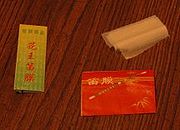
Di mo
Encyclopedia
The dimo is a special membrane applied to the transverse Chinese flute called dizi (or di), giving the instrument its characteristic buzzing timbre
.
 Dimo, made from the tissue-thin membrane from the interior of a specific variety of bamboo, are supplied as tubular sleeves. Only a small rectangle is needed at a time, so for application, a small section is cut off the end of the di mo sleeve, and that small tube is cut open to make a rough rectangle of flat membrane.
Dimo, made from the tissue-thin membrane from the interior of a specific variety of bamboo, are supplied as tubular sleeves. Only a small rectangle is needed at a time, so for application, a small section is cut off the end of the di mo sleeve, and that small tube is cut open to make a rough rectangle of flat membrane.
The Korean transverse bamboo flute called daegeum
has a similar buzzing membrane. The Korean sogeum
and junggeum
and the Thai khlui
also once had membranes, but these are not used today.
After applying the glue around the mo kong, the di mo is applied, and then adjusted while the glue is still wet so that many creases form in a sequence along the length of the hole. Each crease should be parallel to the one before, crossing the hole horizontally, so that together they form a sort of pleat or corrugation.
If Ejiao is not available, a substitute can be improvised by simply crushing garlic
into a fine, relatively dry paste, and applying as normal. It should be used quickly.
Although the purpose of applying di mo is simply to make the dizi operational, the application technique is considered to be an art in itself.
Timbre
In music, timbre is the quality of a musical note or sound or tone that distinguishes different types of sound production, such as voices and musical instruments, such as string instruments, wind instruments, and percussion instruments. The physical characteristics of sound that determine the...
.

The Korean transverse bamboo flute called daegeum
Daegeum
The daegeum is a large bamboo transverse flute used in traditional Korean music. It has a buzzing membrane that gives it a special timbre...
has a similar buzzing membrane. The Korean sogeum
Sogeum
The sogeum is a small bamboo transverse flute used in traditional Korean music. Unlike the larger daegeum, it does not have a buzzing membrane...
and junggeum
Junggeum
The junggeum is a medium-sized bamboo transverse flute formerly used in traditional Korean music. Unlike the larger daegeum, it does not have a buzzing membrane...
and the Thai khlui
Khlui
The khlui is a vertical duct flute from Thailand. It is generally made of bamboo, though instruments are also made from hardwood or plastic...
also once had membranes, but these are not used today.
Application
The di mo is applied to the membrane hole (or Mo kong) of the dizi using a special, traditional glue called Ejiao. One of the advantages of ar jiao is that the glue is water-soluble, so that it can be wetted again to re-adjust the di mo.After applying the glue around the mo kong, the di mo is applied, and then adjusted while the glue is still wet so that many creases form in a sequence along the length of the hole. Each crease should be parallel to the one before, crossing the hole horizontally, so that together they form a sort of pleat or corrugation.
If Ejiao is not available, a substitute can be improvised by simply crushing garlic
Garlic
Allium sativum, commonly known as garlic, is a species in the onion genus, Allium. Its close relatives include the onion, shallot, leek, chive, and rakkyo. Dating back over 6,000 years, garlic is native to central Asia, and has long been a staple in the Mediterranean region, as well as a frequent...
into a fine, relatively dry paste, and applying as normal. It should be used quickly.
Although the purpose of applying di mo is simply to make the dizi operational, the application technique is considered to be an art in itself.

